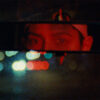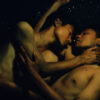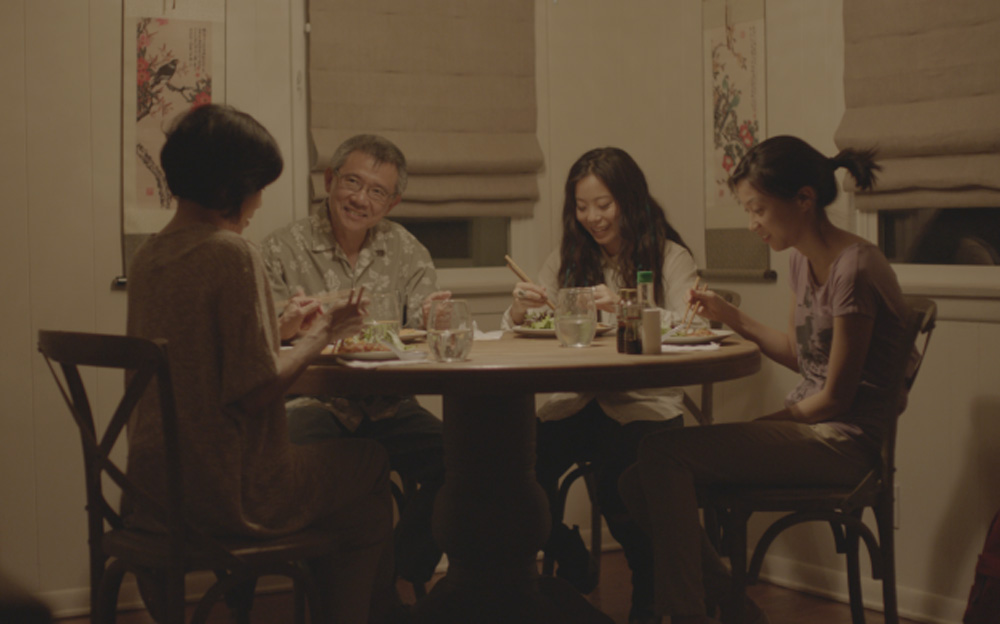There’s a literal cry for help at the start of “For Izzy” that you know is misplaced from the moment you hear the ferocious Dede Chang (Michelle Ang) tear into a customer service department for a health care provider unwilling to fill her prescription for Oxycontin, a complaint that leads into rants about the world at large. Screaming into the void, taking on the cadence of a spoken word performance – she is a multimedia performer, after all – Dede has the beauty of a kite tumbling around in the storm, dancing yet violently moving perilously close to destruction and though she has thoughts of leaving the fast life in L.A. for Hong Kong where she has roots, it is with some chagrin that her mother Anna (Elizabeth Sung) decides to come to stay with her.
In Alex Chu’s second feature, it is the unexpected connections that make for the strongest bonds. It is beautiful to see Anna come to find a kinship with her new next door neighbor Peter (Jim Lau), able to share the struggle of a parent tending to an adult child who still needs supervision as he looks after his autistic daughter Laura (Jennifer Soo), as well as a nostalgia for the same old songs from the island where they grew up, and Dede pick up a new partner-in-crime in Laura, who shares her interest in making videos, satisfying her need to have someone to pay attention to her. However, Chu isn’t only savvy in showing how these complementary relationships form between who might not usually have occasion to meet each other, but the way in which he does so, letting the film unfold in a documentary style that will have you double checking IMDb to make sure what you saw wasn’t nonfiction. Bringing together confessional interviews, street footage shot on iPhones, playful animation and what appears to be verite, the form of “For Izzy” makes it particularly affecting as the various shooting styles conspire to show jagged edges seamlessly fitting into place aesthetically as characters bearing such contours emotionally find the same acceptance in each other’s eyes.
With “For Izzy,” Chu’s compassionate portrayal of addiction, autism and relatives of the afflicted who want to care for them in the best way they can aims to give an audience the same perspective and if the film’s recent premiere at the Ashland Film Festival, where it took home the Audience Award for Best Feature is any indication, it looks like it’s working. Shortly before the Los Angeles premiere of “For Izzy” at the Los Angeles Asian-Pacific Film Festival, Chu and Ang spoke about bringing such a delicate story to the screen so inventively and how excessive planning and rehearsal allowed them to pull off an impossibly demanding production, brimming with life.
How did this come about?
Alex Chu: I’d worked with three of the four actors previously on another feature a few years ago and I wanted to work with them again. Like most writers, you have a cast of characters in a notebook that you’re looking for a home for, and I wanted to find a story for these actors. Addiction runs in my family, it’s a very personal part of my life, and I really wanted to honor that – not the addiction part, but the recovery part of the story, and that’s where the inspiration came.
Michelle, is is true you’re the member of the acting quartet that was X factor?
Michelle Ang: Yes, I’d never worked with Alex before, but I read the script and thought, wow, despite not coming from some super-famous writer/director, this by far is such a standout. It’s so unique. Dede’s voice was so strong to me. One of the audition sides was her doing her spoken word [that’s at the beginning of the film] and I’ve never played a character that’s so opinionated and an artist in that way, with her vocabulary and during our audition process, I really liked Alex’s directing style, so I was like, “If you’re going to give me the role, I would love to come out and help a bit more as well [with producing], if you’ll have me,” so that’s how we found each other.
Did knowing the other three actors actually help shape the story?
Alex Chu: Yeah, and Michelle was also a big part of that. Part of the writing process that I love is the collaboration, and I’ve always found that having other people very involved in the process from the very beginning, including our cinematographer [Irvin Y. Liu], who was involved very early on as well, just in terms of how do we establish the visual language of the film as well, [is helpful]. So the script went through ten revisions or something like that, and a lot of it was just workshopping with the actors. I would bring them together and we’d just go through a readthrough and then they would give me feedback, like “Oh, this doesn’t quite work, this doesn’t feel right.” This isn’t necessarily just about the dialogue. It’s about the relationships of these characters and the world that we’re building.
Michelle Ang: Yeah, it’s a testament to Alex as a writer that he really isn’t precious about it. He’s very open to hearing where we found challenges in terms of relationships and being open to revisiting that. By the end of it, it was a script that everyone understood and felt grounded in.
Alex Chu: Yeah, it’s just like a form of stress testing because it’s a collective effort ultimately. I don’t think film is necessarily a singular vision because if it’s a singular vision then it should be one person in every role doing everything and that’s just not the case.
It’s interesting to hear the cinematographer was part of that process because the characters actually do express themselves visually in the film since you see both Dede and Laura filming at times, and of course, the style of the film lends itself to conveying emotion in distance from the camera. What were the evolution of those ideas?
Michelle Ang: That’s very true actually because playing the primary film documenter, we had a real working phone that was doing the recording. Sometimes I would have to hold it, but then our DP would have to frame it or choose a style and when you don’t see who’s behind the camera and you want to convey a different character, there’s different ways that character might hold their phone or frame a shot. So that was an angle of cinematic expression that we really had to carve out and I think it was a new field for our DP [because] he’d worked with [professional] cameras, but he hadn’t worked with things like iPhones and video cams before.
Alex Chu: The actors, particularly Michelle and Jenny, who were holding the cameras for their characters, were really good on set. As much planning as you want to do, there’s still things you miss once you’re [filming] and Michelle and Jenny were really great about pushing us, asking questions. They were not afraid to say, “Why would my character do this? Why would my character hold the phone this way?” That was really helpful because it really forced us to be as specific as possible in ways that we thought we were, but to have people on set being able to put that forward [practically].
Michelle Ang: Yeah, so it’s not contrived. [There were moments where you’d think as a character] “Well, that’s weird. Why would I be holding my phone angled on myself while I’m trying to open a door? That doesn’t make sense. You would be seeing the doorknob. Or my pocket.” So the need for it being shot was always part of the reality of the characters. And then there is a film within a film, so there’s a more traditional camera telling the story and then there’s Dede as a filmmaker [herself] doing the shooting and then there’s also the found footage stuff, so we worked really hard with our cinematographer to make sure that everything storywise would fit into one of those three [visual] languages.
Did the documentary style of this come to you immediately?
Alex Chu: That was pretty early on as a function of the limitations that we had. It opened a creative door for me [because] I wanted to really make a film, [but had to ask myself] how do we do it in a way that is possible? So you work backwards from there and that forces you to ask certain questions that you normally would not ask if you had a much bigger budget. The documentary style started off that way, which was how do we convey a lot of information about the story without it being traditionally cinematic, and the animation became a function of that as well.
Part of what makes the documentary style so effective is that you film in so many locations – you never think this is constrained by the limitations of a movie shoot. What was it like moving all around Los Angeles, from Pasadena and Griffith Park, all the way up to San Francisco?
Alex Chu: That was the most difficult thing. I wrote down the stats. We shot for 17 days, and that includes travel to San Francisco and we did all of that within 21 calendar days. And we did 253 scenes and a gazillion inserts, so when it came to actual shooting, we had so many set-ups just to get through the day. It was one of those miracles where we did not miss a single shot we had planned to do and that was a testament to everybody on set and the fact that so many of the principals – the lead actors, our cinematographer, our production designer – planned the hell out of this beforehand, anticipating it was going to be a difficult shoot. Of course, it still ended up being more difficult than we ever anticipated, but this would not have ended up happening without all that advanced rehearsal that we did, so by the time we ended up shooting, we were making the same movie. Yes, I wish we had more time to explore certain things, but if you can’t, you can still work as a machine and everybody is on the same page.
Michelle Ang: I never walked away from any scene feeling dissatisfied that there was something that I hadn’t managed to explore or show, which is a pretty big thing to say on a film.
There’s a scene at the street fair in Pasadena that looked pretty wild to shoot in – were you just responding to the environment?
Michelle Ang: That was fortuitous because we didn’t know there was going to be a fair. We were like, “Wow, we just scored 300 extras for free.” That’s an example of being open to the creative possibilities and because we were shooting in a small unit on an iPhone, we were able to take advantage of these miraculous situations and just jump in there and find the story bite that we needed.
Was this tricky to edit when you have all these competing styles or was this planned enough you had a pretty good idea what this would look like at the end?
Alex Chu: We brought on an editor Michelle knows, Peter Roberts, who’s done a lot of documentary editing, and we were looking for someone who had that experience in putting together mixed media. The reason why it worked, I think, is because how we set up sequences [during shooting], we were mixing it in the right way. Certain sequences lived in its own world – you had all the iPhone footage in one sequence and the language of the camera was cohesive in a way that it didn’t feel like things were out of place. So when we were able to cut it together, it was actually a relatively smooth process.
Michelle Ang: And fun fact – Alex and [Peter] only communicated only through the internet. They never had any in-person editing sessions because Peter’s based in New Zealand.
Alex Chu: Yeah, he was editing out of the WETA studios because he was editing for our film while editing for Peter Jackson-related projects at the same time, so we’d just have these Skype sessions where we’d send stuff back and forth.
What’s it like getting to the premiere?
Alex Chu: It’s exciting. At Ashland, they gave us six screenings and we got an additional seventh screening after we won the audience award and I was really surprised and heartened by the response. From a technical standpoint, I was really surprised [because] the iPhone footage we shot was on older iPhone – sixes or fives, so when you get to see the film on the big screen for the first time, I was very skeptical about whether the iPhone footage would hold up and I was really surprised how well it stood up, better than I would’ve ever anticipated.
And at Ashland, there were a lot of people who were RNs or counselors or people who worked in the addiction or recovery community and also the disability community, so to hear them talk about the film and validate a lot of the themes we were talking about in the film, really made a huge difference for me because in many ways the film is for people in that community more than anything else.
Michelle Ang: There’s always a tinge of terror involved, but I’m really proud of it. This is my first film that I’ve been part of the producing and creative process and I wasn’t in Ashland, but I would like to see how the L.A. audience responds and see if our story moves some people.
“For Izzy” will play at the L.A. Asian-Pacific Film Festival on May 7th at 7:30 pm at the Regal L.A. Live.




